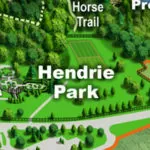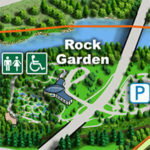| Membership | Price (+HST) |
|---|---|
| Single | $85/year |
| Single Plus | $120/year |
| Family | $130/year |
| Family Plus | $175/year |
| Contributing | $300/year |
| Supporting | $600/year |
| Sustaining | $1,000/year |
| Benefactor's Circle | $2,500/year |
| Director's Circle | $5,000/year |
| President's Circle | $10,000/year |
Impacts of Wildlife Feeding Along RBG Trails
By Jennifer Dick and Barb McKean, Royal Botanical Gardens.
Wildlife in RBG’s nature sanctuaries have a problem — and the problem is overfeeding. A recent study discovered that the frequency and amount of feeding wildlife in hotspot areas such as Hendrie Valley Nature Sanctuary is doing far more harm than good.
Spending time in nature has many positive benefits. RBG offers a 27-km network of hiking trails through 2,100 acres of nature sanctuaries for visitors looking to connect with nature in and around the cities of Burlington and Hamilton. In addition to hiking, a popular way to connect with nature is through wildlife encounters. For guests visiting our trails, that often happens by feeding animals like birds and chipmunks. Feeding gives an up-close encounter with wildlife and warm fuzzy feelings for those who think they’re ‘helping’ them survive.
Although feeding birds in your city backyard might help them, it turns out that wildlife feeding in protected nature sanctuaries like RBG’s harms not just the animals, but the health of the whole ecosystem. RBG, the City of Hamilton, and the City of Burlington have bylaws in place to help protect wildlife and their habitat, so our visitors may notice “No Feeding” signs along the trails. To shed some light on the reasons for these rules, we’d like to share some of the conclusions from this study.


Impacts of Feeding
Birds need a high energy diet and many seed mixes available are not beneficial for Ontario native species. If they fill up on lower quality foods found in mixed seed, like corn, they won’t get all the nutrients they need even on a full stomach. These seed mixes also introduce possible new invasive plants into the nature sanctuaries. The RBG Botany team has found plants like millet growing along the trails from bird seed left behind.
There are long-term concerns for our forests if our birds and mammals aren’t foraging on their natural foods in the sanctuaries. Squirrels and chipmunks are nature’s tree planters. If their diet is being supplemented, this could mean that tree nuts such as acorns, walnuts, and hickories aren’t being distributed which could change the structure of our future forest over time.
RBG’s nature sanctuaries are home to dozens of species at risk including Blanding’s Turtles, Wood Thrush, and Eastern Wood-Pewee. Someone may think that leaving birdseed along our trails is helping birds, but actually it’s feeding a soaring population of predatory omnivores like skunks, opossums and raccoons (and squirrels and chipmunks). And what will all those extra predators eat, along with birdseed? Turtle and bird eggs and young are high on the list. And RBG’s rare species become even rarer as a result. Overpopulation of wildlife in the small areas around RBG’s birdfeeding hotspots also poses a threat to animal health and wellbeing. High concentrations of animals can lead to increased stress, aggression, and the rapid spread of disease.
An additional (and hazardous!) aspect of feeding wildlife here is the introduction of peanut protein into nature sanctuaries. Whether feeding animals peanuts in the shell or as part of a birdseed mix, this creates a hazard for children with anaphylactic nut allergies who touch railings, logs or benches where seed has been sprinkled.
By not introducing food into RBG’s nature sanctuaries, you support a healthy natural balance in RBG’s habitat for all.


How to Help
The most effective way for each of us to help wildlife is to provide natural habitat for them. In addition to supporting RBG nature sanctuaries, we can all help wildlife by planting native flowers, trees, and grasses in our yards and communities. Even small areas of native plants provide habitat that offers natural food sources and shelter to animals.
Ultimately, best practice for wildlife encounters in protected natural areas are low impact activities where you observe what is happening in nature around you. Try taking some binoculars along with you to get an up-close look. Borrow a field guide from your library to help identify the plants and animals you see. Check out the iNaturalist app to contribute to citizen science where your observations could even help RBG researchers.
We hope you enjoy your time on the trails! Let us know what you see.


Learn More with our Video Series:
Nature Sanctuaries & Conservation
The nature sanctuaries cover 900 hectares of land at the head of Lake Ontario forming a Nodal Park in the Niagara Escarpment World Biosphere Region. The sanctuaries feature more than 27 kilometres of scenic walking trails.
More from the RBG Blog
Check out RBG’s blog for announcements, articles, and more from Canada’s largest botanical garden.
Want to be sure you hear first? Sign up for our weekly e-newsletter to hear about upcoming events, weekend activities, articles, and more!












